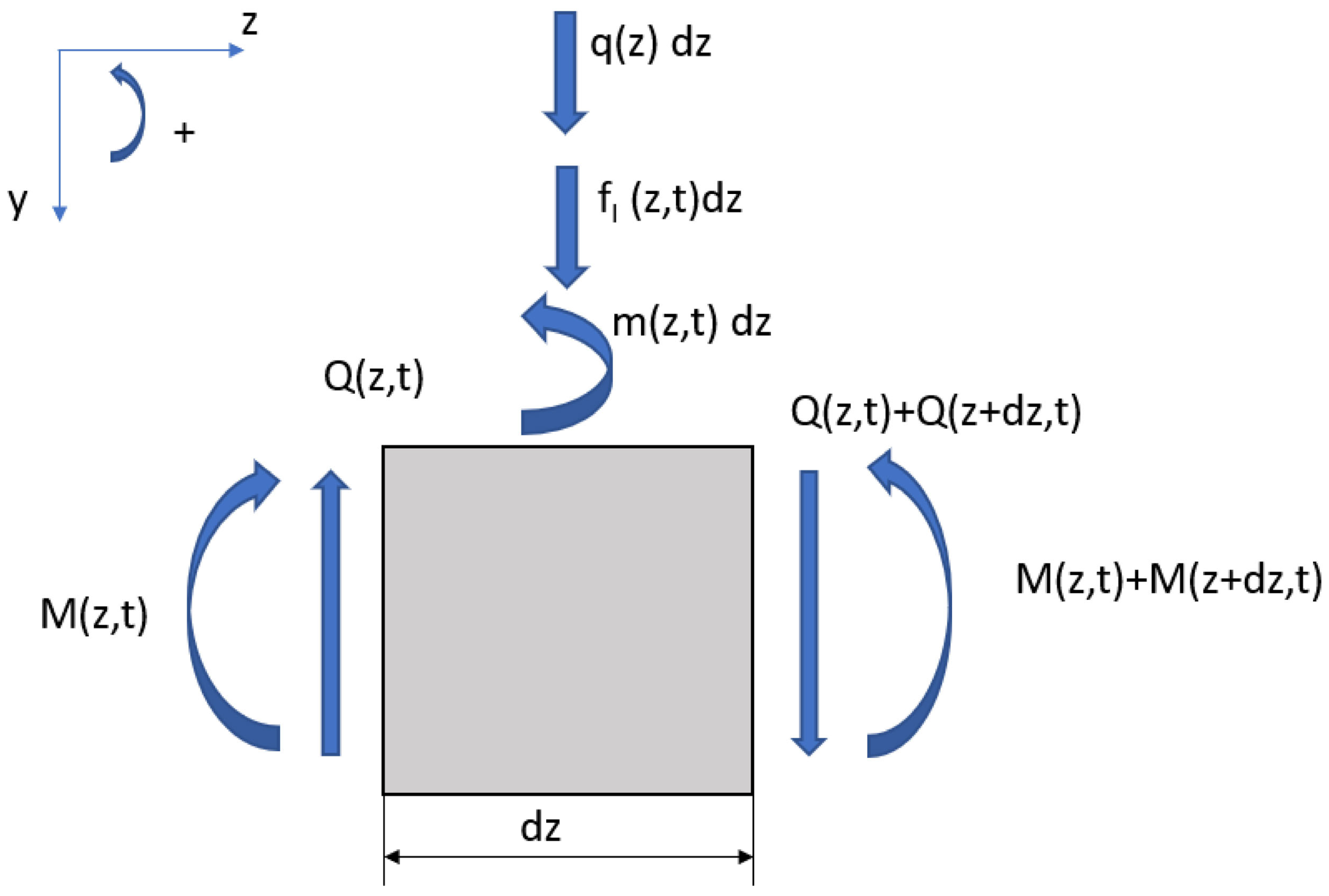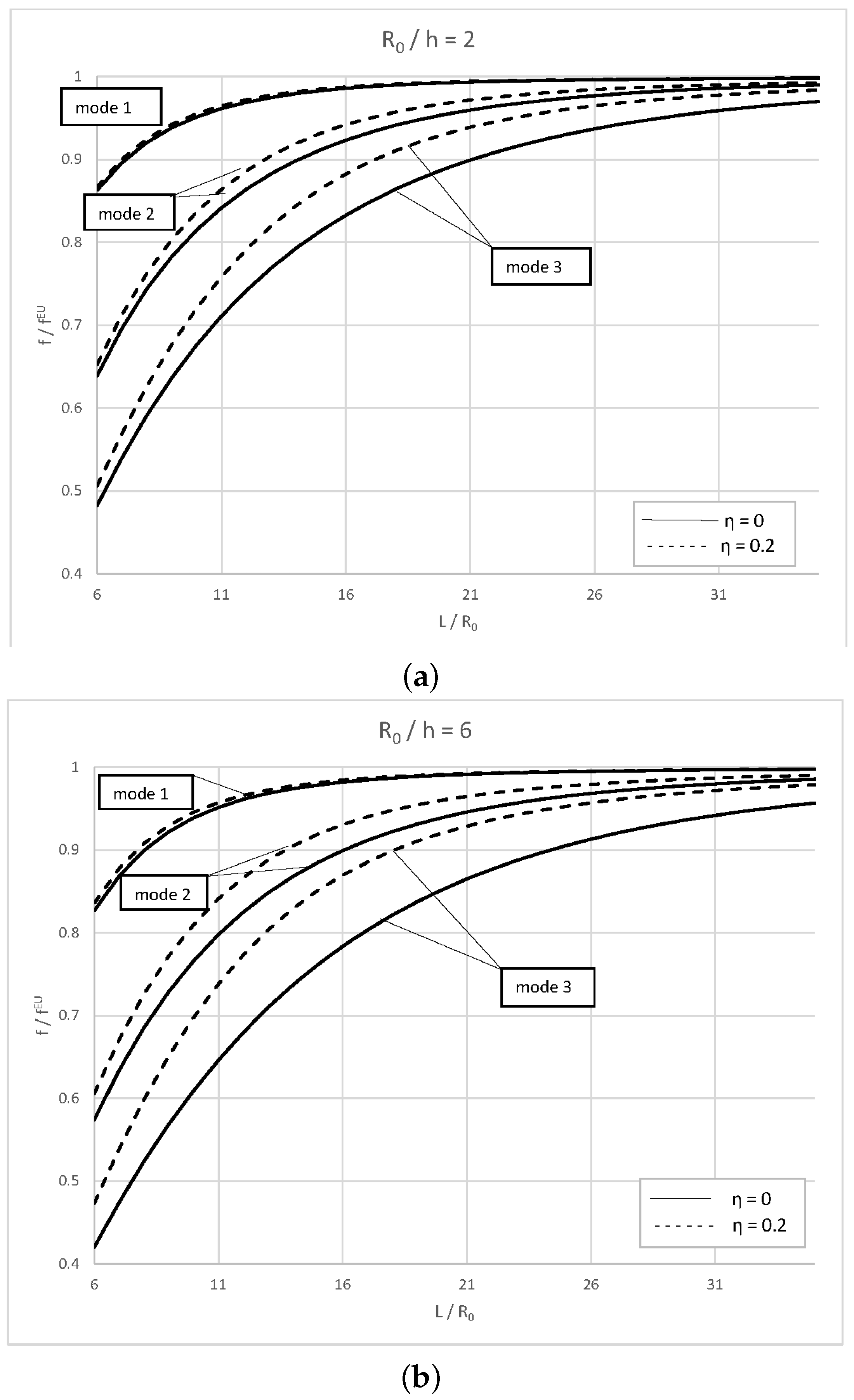Dynamic Analysis of a Timoshenko–Ehrenfest Single-Walled Carbon Nanotube in the Presence of Surface Effects: The Truncated Theory
Abstract
:1. Introduction
2. Eringen Nonlocal Theory and Surface Theory for Nonlocal Timoshenko–Ehrenfest Nanotube Analysis
2.1. Eringen Nonlocal Theory Assumptions and Stress Resultants in Nonlocal Theory
2.2. Surface Effect Theory for Nanotube Analysis
3. Theoretical Formulation: Equations of Motion for Nonlocal Truncated Timoshenko–Ehrenfest Beam Models for Nanotube Analysis
3.1. Equation of Motion for a Truncated Timoshenko–Ehrenfest Beam: Euler Method
3.2. Equations of Motion for a Truncated Timoshenko–Ehrenfest Beam: Variational Method
3.3. Equations of Motion for Nonlocal Truncated Timoshenko–Ehrenfest Nanotubes
3.4. Solving the System of Differential Equations of Nonlocal Truncated Timoshenko–Ehrenfest Nanotubes
The Case of the Simply Supported Nanotube
4. Numerical Results and Discussion
4.1. Effect of Surface and Nonlocal Parameters on the Frequency Ratio of Timoshenko–Ehrenfest Nanotubes
4.2. Effect of Surface and Nonlocal Parameters on the Frequency Ratio of Timoshenko–Ehrenfest Nanotubes by Varying the Constant Ratio /h
5. Concluding Remarks
Author Contributions
Funding
Informed Consent Statement
Conflicts of Interest
References
- Krishnan, A.; Dujardin, E.; Ebbesen, T.W.; Yianilos, P.N.; Treacy, M.M.J. Young’s modulus of single-walled nanotubes. Phys. Rev. B 1998, 58, 14013–14019. [Google Scholar] [CrossRef]
- Demczyk, B.G.; Wang, Y.M.; Cumings, J.; Hetman, M.; Han, W.; Zettl, A.; Ritchie, R.O. Direct mechanical measurement of the tensile strength and elastic modulus of multiwalled carbon nanotubes. Mat. Sci. Eng. A 2002, 334, 173–178. [Google Scholar] [CrossRef]
- Ruoff, R.S.; Qian, D.; Liu, W.K. Mechanical properties of carbon nanotubes: Theoretical predictions and experimental measurements. Comp. Rendus Phys. 2003, 4, 993–1008. [Google Scholar] [CrossRef]
- Ansari, R.; Rouhi, H.; Nasiri, R.A. Vibrational analysis of carbon nanocones under different boundary conditions: An analytical approach. Mech. Res. Comm. 2014, 56, 130–135. [Google Scholar] [CrossRef]
- Elishakoff, I.; Versaci, C.; Muscolino, G. Clamped-free double-walled carbon nanotube-based mass sensor. Acta Mech. 2011, 219, 29–43. [Google Scholar] [CrossRef]
- Elishakoff, I.; Pentaras, D. Fundamental natural frequencies of double-walled nanotubes. Int. J. Sound Vibr. 2009, 322, 652–664. [Google Scholar] [CrossRef]
- Ru, C.Q. Column buckling of multiwalled carbon nanotubes with interlayer radial displacements. Phys. Rev. B 2000, 62, 16962–16967. [Google Scholar] [CrossRef]
- Wang, Q.; Hu, T.; Chen, Q.J. Bending instability characteristics of double walled nanotubes. Phys. Rev. B 2005, 71, 045403. [Google Scholar] [CrossRef]
- Rosa, M.A.D.; Lippiello, M.; Babilio, E.; Ceraldi, C. Nonlocal vibration analysis of a nonuniformcarbon nanotube with elastic constraints and an attached mass. Materials 2021, 14, 3445. [Google Scholar] [CrossRef]
- Rosa, M.A.D.; Lippiello, M.; Onorato, A.; Elishakoff, I. Free vibration of single-walled carbon nanotubes using nonlocal truncated Timoshenko-Ehrenfest beam theory. Appl. Mech. 2023, 4, 699–714. [Google Scholar] [CrossRef]
- Rosa, M.A.D.; Lippiello, M. Free vibration analysis of DWCNTs using CDM and Rayleigh-Schimdt based on nonlocal Euler-Bernoulli beam theory. Sci. World J. 2014, 194529. [Google Scholar]
- Reddy, J.N.; Pang, S.D. Nonlocal continuum theories of beams for the analysis of carbon nanotubes. J. Appl. Phys. 1998, 103, 023511. [Google Scholar] [CrossRef]
- Rosa, M.A.D.; Lippiello, M. Hamilton principle for SWCN and a modified approach for nonlocal frequency analysis of nanoscale biosensor. Int. J. Recent Sci. Res. (IJRSR) 2015, 6, 2355–2365. [Google Scholar]
- Reddy, J.N. Nonlocal theories for bending, buckling and vibration of beams. Int. J. Eng. Sci. 2007, 45, 288–307. [Google Scholar] [CrossRef]
- Eringen, A.C. Nonlocal polar elastic continua. Int. J. Eng. Sci. 1972, 10, 288–307. [Google Scholar] [CrossRef]
- Eringen, A.C. On differential equations of non local elasticity and solutions of screw dislocation and surface-waves. J. Appl. Phys. 1983, 54, 4703–4710. [Google Scholar] [CrossRef]
- Kucuk, I.; Sadek, I.S.; Adali, S. Variational principles for multiwalled carbon nanotubes undergoing vibrations on nonlocal Timoshenko beam theory. J. Nanomater. 2010, 2010, 461252. [Google Scholar] [CrossRef]
- Rosa, M.A.D.; Lippiello, M.; Martin, H.D. Free vibrations of a cantilevered SWCNT with distributed mass in the presence of non local effect. Sci. World J. 2015, 2015, 825342. [Google Scholar]
- Rosa, M.A.D.; Lippiello, M. Nonlocal frequency analysis of embedded singlewalled carbon nanotube using the Differential Quadrature Method. Comp. Part B 2016, 84, 41–51. [Google Scholar] [CrossRef]
- Rosa, M.A.D.; Lippiello, M.; Martin, H.D.; Piovan, M.T. Nonlocal frequency analysis of nanosensors with different boundary conditions and attached distributed biomolecules: An approximate method. Acta Mech. 2016, 227, 2323–2342. [Google Scholar] [CrossRef]
- Rosa, M.A.D.; Lippiello, M. Nonlocal Timoshenko frequency analysis of single-walled carbon nanotube with attached mass: An alternative Hamiltonian approach. Comp. Part B 2017, 111, 409–418. [Google Scholar] [CrossRef]
- Rosa, M.A.D.; Lippiello, M.; Tomasiello, S. Differential quadrature solutions for the nonconservative instability of a class of single-walled carbon nanotubes. Eng. Comp. 2018, 35, 251–267. [Google Scholar] [CrossRef]
- Auciello, N.M.; Rosa, M.A.D.; Lippiello, M.; Tomasiello, S. Non-conservative instability of cantilevered nanotube via cell discretization method. Springer Proc. Math. Stat. 2018, 248, 13–24. [Google Scholar]
- Rosa, M.A.D.; Lippiello, M.; Auciello, N.M.; Martin, H.D.; Piovan, M.T. Variational method for non-conservative instability of a cantilever SWCNT in the presence of variable mass or crack. Arch. Appl. Mech. 2021, 91, 301–316. [Google Scholar] [CrossRef]
- He, J.; Lilley, C.M. Surface Effect on the Elastic Behavior of Static Bending Nanowires. Nano Lett. 2008, 8, 1798–1802. [Google Scholar] [CrossRef] [PubMed]
- Wang, G.F.; Feng, X.Q. Timoshenko beam model for buckling and vibration of nanowires with surface effects. J. Phys. D Appl. Phys. 2009, 42, 1554111. [Google Scholar] [CrossRef]
- Lee, H.; Chang, W.J. Surface effects on frequency analysis of nanotubes using nonlocal Timoshenko beam theory. J. Appl. Phys. 2010, 108, 093503. [Google Scholar] [CrossRef]
- Farshi, B.; Assadi, A.; Alinia-Ziazi, A. Frequency analysis of nanotubes with consideration of surface effects. Appl. Phys. Lett. 2010, 96, 093105. [Google Scholar] [CrossRef]
- Jiang, L.Y.; Yan, Z. Timoshenko beam model for static bending of nanowires with surface effects. Physica E 2010, 42, 2274–2279. [Google Scholar] [CrossRef]
- Challamel, N.; Elishakoff, I. Surface stress effects may induces oftening: Euler-bernoulli and timoshenko buckling solutions. Physica E 2012, 44, 1862–1867. [Google Scholar] [CrossRef]
- Kasirajan, P.; Amirtham, R.; Reddy, J.N. Surface and non-local effects for non-linear analysis of timoshenko beams. Int. J. Non-Linear Mech. 2015, 76, 100–111. [Google Scholar] [CrossRef]
- Gurtin, M.E.; Murdoch, A.I. A continuum theory of elastic material surfaces. Arch. Rat. Mech. Anal. 1975, 57, 291–323. [Google Scholar] [CrossRef]
- Gurtin, M.E.; Murdoch, A.I. Surface stress in solids. Int. J. Sol. Struct. 1978, 14, 431–440. [Google Scholar] [CrossRef]
- Rosa, M.A.D.; Lippiello, M.; Elishakoff, I. Variational Derivation of Truncated Timoshenko-Ehrenfest Beam Theory. J. Appl. Comput. Mech. 2022, 8, 996–1004. [Google Scholar]
- Wolfram, S. The Mathematica 8; Cambridge University Press: Cambridge, UK, 2010. [Google Scholar]
- Wu, C.P.; Lai, W.W. Free vibration of an embedded single-walled carbon nanotube with various boundary conditions using the RMVT-based nonlocal Timoshenko beam theory and DQ method. Phys. E Low-Dimens. Syst. Nanostruct. 2015, 68, 8–21. [Google Scholar] [CrossRef]




| = 0 | = 0.2 | = 0.4 | |
|---|---|---|---|
| 1 | 0.9574 | 0.9600 | 0.9657 |
| 2 | 0.9514 | 0.9553 | 0.9631 |
| 3 | 0.9459 | 0.9508 | 0.9601 |
| 4 | 0.9426 | 0.9483 | 0.9587 |
| 5 | 0.9405 | 0.9468 | 0.9579 |
| 6 | 0.9390 | 0.9457 | 0.9574 |
| 7 | 0.9377 | 0.9449 | 0.9571 |
| 8 | 0.9367 | 0.9442 | 0.9569 |
| 9 | 0.9357 | 0.9436 | 0.9567 |
| 10 | 0.9349 | 0.9431 | 0.9565 |
Disclaimer/Publisher’s Note: The statements, opinions and data contained in all publications are solely those of the individual author(s) and contributor(s) and not of MDPI and/or the editor(s). MDPI and/or the editor(s) disclaim responsibility for any injury to people or property resulting from any ideas, methods, instructions or products referred to in the content. |
© 2023 by the authors. Licensee MDPI, Basel, Switzerland. This article is an open access article distributed under the terms and conditions of the Creative Commons Attribution (CC BY) license (https://creativecommons.org/licenses/by/4.0/).
Share and Cite
De Rosa, M.A.; Elishakoff, I.; Onorato, A.; Lippiello, M. Dynamic Analysis of a Timoshenko–Ehrenfest Single-Walled Carbon Nanotube in the Presence of Surface Effects: The Truncated Theory. Appl. Mech. 2023, 4, 1100-1113. https://doi.org/10.3390/applmech4040056
De Rosa MA, Elishakoff I, Onorato A, Lippiello M. Dynamic Analysis of a Timoshenko–Ehrenfest Single-Walled Carbon Nanotube in the Presence of Surface Effects: The Truncated Theory. Applied Mechanics. 2023; 4(4):1100-1113. https://doi.org/10.3390/applmech4040056
Chicago/Turabian StyleDe Rosa, Maria Anna, Isaac Elishakoff, Antonella Onorato, and Maria Lippiello. 2023. "Dynamic Analysis of a Timoshenko–Ehrenfest Single-Walled Carbon Nanotube in the Presence of Surface Effects: The Truncated Theory" Applied Mechanics 4, no. 4: 1100-1113. https://doi.org/10.3390/applmech4040056
APA StyleDe Rosa, M. A., Elishakoff, I., Onorato, A., & Lippiello, M. (2023). Dynamic Analysis of a Timoshenko–Ehrenfest Single-Walled Carbon Nanotube in the Presence of Surface Effects: The Truncated Theory. Applied Mechanics, 4(4), 1100-1113. https://doi.org/10.3390/applmech4040056







